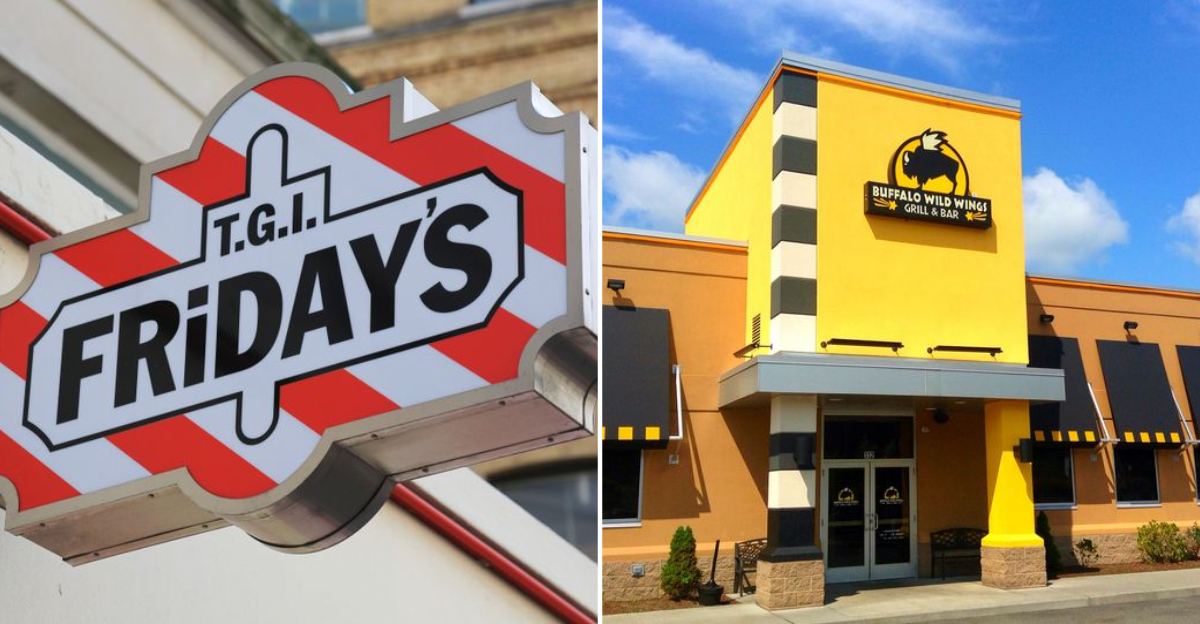15 Chains That Washington Diners Are Skipping More Often

Washington’s dining scene is changing as local foodies shift their loyalties away from once-popular restaurant chains.
I’ve noticed this trend during my weekend outings with friends, where we increasingly choose local spots over familiar national brands.
Many chains that were packed just a few years ago now have plenty of empty tables, even during traditional rush hours.
Let’s explore which restaurant chains are losing their appeal with Washington diners and why these former favorites are being left behind.
1. Olive Garden’s Endless Breadstick Blues
Remember when waiting 45 minutes for a table at Olive Garden seemed perfectly reasonable? Not anymore! Washington diners are increasingly passing on those famous breadsticks and formulaic Italian-American dishes.
During my last visit to the Lynnwood location, I counted more servers than customers—a stark contrast to the packed houses of yesteryear. Many locals cite the predictable menu that hasn’t evolved meaningfully in years as their reason for straying.
The chain’s corporate feel and mass-produced food experience simply can’t compete with the authentic Italian eateries popping up across the state. When Washingtonians can get handmade pasta from a family-owned trattoria for similar prices, those unlimited breadsticks lose their unlimited appeal.
2. Applebee’s Neighborhood Neglect
“Eatin’ good in the neighborhood” has become “eatin’ elsewhere” for many Washington residents. The once-bustling Applebee’s locations throughout the state are experiencing a noticeable customer drought.
Last month, I popped into the Tacoma Applebee’s for a quick lunch, only to find myself with practically the entire restaurant to myself. The chain’s attempt to balance being a family restaurant, sports bar, and late-night hangout has resulted in an identity crisis that’s driving customers away.
Local diners increasingly prefer places that excel at one concept rather than trying to be everything to everyone. Plus, the microwaved-feeling food and cookie-cutter ambiance have lost their charm as Washington’s food scene has matured and diversified.
3. Chili’s Cooling Customer Interest
Those baby back ribs aren’t bringing Washingtonians back like they used to! Chili’s locations across the state are seeing fewer patrons lining up for their Tex-Mex inspired offerings and signature cocktails.
While shopping at Southcenter Mall last weekend, I noticed the adjacent Chili’s had more staff than diners—even during the Saturday dinner rush. The chain’s reliance on frozen ingredients and microwave-heavy preparation methods has become increasingly apparent to discerning local palates.
Washington’s growing preference for fresh, locally-sourced ingredients has left Chili’s feeling outdated. Even their famous queso and margaritas can’t compete with the authentic Mexican restaurants and craft cocktail bars that have flourished throughout the Evergreen State in recent years.
4. Red Lobster’s Sinking Ship
Those addictive cheddar bay biscuits aren’t enough to keep Red Lobster afloat in Washington anymore. The seafood chain is struggling mightily in a state renowned for its fresh, local seafood options.
I recently drove past the Everett location on a Friday night—traditionally their busiest time—and was shocked to see only a handful of cars in the parking lot. Washington diners have grown increasingly sophisticated about their seafood, preferring locally-caught options over Red Lobster’s often frozen, imported offerings.
The chain’s corporate ownership troubles and menu price increases haven’t helped either. When Washingtonians can enjoy fresh Puget Sound seafood at local fish markets and restaurants for comparable prices, Red Lobster’s appeal continues to sink like an anchor.
5. TGI Fridays’ Fading Frivolity
The party atmosphere that once defined TGI Fridays has lost its sparkle for Washington diners. Those red-and-white stripes now signal dated decor rather than fun times ahead.
During a recent work happy hour, our group of six practically had the entire Northgate TGI Fridays to ourselves. The chain’s kitschy memorabilia and manufactured “flair” that seemed charming in the 90s now feels like a tired theme park of casual dining.
Washington’s booming craft brewery scene and innovative local pubs have rendered Fridays’ concept obsolete. Why settle for mass-produced potato skins and sugary cocktails when you can enjoy locally-crafted beers and creative gastropub fare just down the street? That Friday feeling isn’t what it used to be.
6. Outback Steakhouse’s Withering Appeal
G’day? More like goodbye! Outback Steakhouse’s faux-Australian theme is losing its charm faster than you can say “Bloomin’ Onion.” Washington’s carnivores are increasingly looking elsewhere for their steak fix.
Last month, I met an old friend at the Bellevue Outback and was startled by how easy it was to get a table without a reservation on a Saturday night. The chain’s over-salted steaks and theatrical presentation can’t compete with Washington’s thriving local steakhouse scene and farm-to-table restaurants.
Many diners I’ve spoken with cite the chain’s inflated prices for mediocre cuts as their main reason for abandoning ship. When Washingtonians can enjoy locally-raised beef prepared by skilled chefs for similar prices, that Australian accent starts to sound pretty phony.
7. LongHorn Steakhouse’s Lonely Prairie
The tumbleweeds might as well be rolling through LongHorn Steakhouse locations across Washington. This chain’s Western-themed steakhouse concept is struggling to maintain relevance in the Pacific Northwest.
I stopped by the Tacoma location recently, curious about the conspicuously empty parking lot during prime dinner hours. Inside, the dated cowboy decor and predictable menu offerings explained a lot about the customer shortage. Washington’s sophisticated diners have moved beyond the kitschy ranch theming and basic steak-and-potato formula.
Local steakhouses offering dry-aged selections, innovative preparations, and Washington-raised beef have simply left LongHorn in the dust. Even the chain’s famous “Flo’s Filet” can’t compete with the authentic steakhouse experiences that have proliferated across the state in recent years.
8. Carrabba’s Italian Grill’s Cooling Pasta
Mamma mia! Carrabba’s Italian Grill isn’t drawing crowds like it used to in the Evergreen State. The chain’s attempt at upscale Italian-American cuisine is falling flat with Washington’s increasingly discerning diners.
During a recent family celebration, we were surprised to walk right into the Kirkland location without any wait on a Friday evening. The dining room was eerily quiet for what should have been peak hours. Washington’s flourishing authentic Italian restaurant scene has raised expectations beyond what this chain can deliver.
Local pasta lovers now gravitate toward small, chef-driven Italian spots where pasta is made fresh daily and recipes reflect regional Italian cooking rather than Americanized versions. When genuine Italian cuisine is readily available, Carrabba’s middle-of-the-road approach simply doesn’t cut the mustard—or should I say, the parmigiano.
9. Ruby Tuesday’s Fading Gem
What a difference a decade makes! Ruby Tuesday locations across Washington state have transformed from bustling casual dining hotspots to quiet, often empty dining rooms with plenty of available parking.
Last Tuesday (ironically), I stopped by the Vancouver location for a quick lunch and found myself among just three other occupied tables. The chain’s attempt to reinvent itself multiple times has left customers confused about what Ruby Tuesday actually stands for these days.
Washington diners have moved beyond the basic salad bar and uninspired burger options that were once the chain’s claim to fame. With so many local restaurants offering creative, chef-driven casual cuisine, Ruby Tuesday’s cookie-cutter approach feels increasingly irrelevant to the state’s evolving food culture.
10. P.F. Chang’s Diminishing Dynasty
Those iconic horse statues are guarding increasingly empty restaurants across Washington state. P.F. Chang’s, once the go-to for “fancy” Chinese food, is losing its luster with local diners.
I recently met colleagues for a dinner meeting at the Seattle location and was shocked that we were seated immediately during what should have been the evening rush. Washington’s booming authentic Asian food scene has exposed the chain’s Americanized versions of Chinese cuisine for what they truly are—overpriced and underwhelming approximations of the real thing.
With the state’s abundance of genuine Chinese restaurants spanning regional specialties from Sichuan to Cantonese, why would anyone pay premium prices for P.F. Chang’s watered-down versions? Those lettuce wraps just don’t hold the same appeal they once did.
11. Golden Corral’s Tarnished Buffet
The endless buffet concept is finding fewer takers in Washington these days. Golden Corral locations throughout the state are experiencing a significant decline in foot traffic, even during traditional meal rushes.
I drove past the Marysville location recently during Sunday brunch—historically their busiest time—and was stunned by how few cars occupied the spacious parking lot. The all-you-can-eat model that once attracted families and budget-conscious diners has lost its appeal in a state increasingly focused on quality over quantity.
Washington’s growing emphasis on sustainable, locally-sourced food makes Golden Corral’s mass-produced buffet offerings feel out of step with current values. The pandemic also permanently changed many diners’ comfort levels with self-serve food stations and communal serving utensils.
12. Red Robin’s Burger Burnout
The bottomless fries aren’t enough to keep Washington diners flocking to Red Robin anymore. Despite the chain’s local roots (it started in Seattle!), Red Robin locations across the state are serving fewer “yummm” burgers than ever before.
I recently visited the Tukwila location with my nephew and was surprised to find no wait for a table on a Saturday afternoon. Washington’s exploding gourmet burger scene has raised the bar well beyond what this chain can deliver. Locals now expect house-ground beef, artisanal buns, and creative toppings that make Red Robin’s offerings seem basic by comparison.
The chain’s family-friendly atmosphere still attracts some parents with young children, but adults without kids in tow are increasingly choosing local burger joints that offer better quality and more interesting flavor profiles.
13. Buffalo Wild Wings’ Flavor Fatigue
The sports bar scene in Washington is evolving beyond Buffalo Wild Wings’ formula of TVs, beer, and wings. Even during major sporting events, the chain’s locations throughout the state are no longer guaranteed to be packed.
During last month’s Seahawks game, I was shocked to walk right into the Bellingham location and get a prime table without any wait. Washington’s flourishing craft brewery scene has created countless local sports bars with better beer selections, higher quality food, and more authentic atmospheres.
The chain’s standardized wing flavors and frozen-then-fried approach can’t compete with local spots offering fresh, innovative takes on the classic sports bar fare. When Washingtonians can watch the game while enjoying locally-brewed IPAs and wings with unique, chef-created sauces, Buffalo Wild Wings’ appeal simply fizzles.
14. The Cheesecake Factory’s Shrinking Slice
Those famous wait times at The Cheesecake Factory are becoming a thing of the past in Washington. The chain known for its encyclopedic menu and massive portions is seeing smaller crowds across its locations in the state.
Just last weekend, I was stunned when my family was seated immediately at the Bellevue Square location on a Saturday night. Washington diners are increasingly questioning the quality-to-price ratio of the chain’s offerings, especially as local restaurants provide more specialized, authentic experiences.
The novel-length menu that was once a selling point now reads as a red flag to food-savvy Washingtonians who understand that no kitchen can excel at preparing hundreds of different dishes. Even the namesake cheesecakes, while still popular for takeout, aren’t enough to fill dining rooms like they once did.
15. Cracker Barrel’s Country Road Less Traveled
Those rocking chairs on the front porch are getting plenty of rest these days. Cracker Barrel locations in Washington are seeing fewer diners stopping in for country-style comfort food and nostalgic gift shop browsing.
During a recent road trip, I pulled off I-5 to grab breakfast at the Lacey location and found the usually bustling restaurant oddly quiet. The chain’s Southern-focused menu and old-timey aesthetic that seem charming in other parts of the country feel somewhat out of place in the Pacific Northwest’s progressive food culture.
Washington’s robust breakfast scene offers plenty of locally-owned diners and brunch spots serving similar comfort foods with fresher ingredients and regional twists. When locals can get better biscuits and gravy or pancakes at a neighborhood spot, the appeal of Cracker Barrel’s manufactured nostalgia significantly diminishes.
